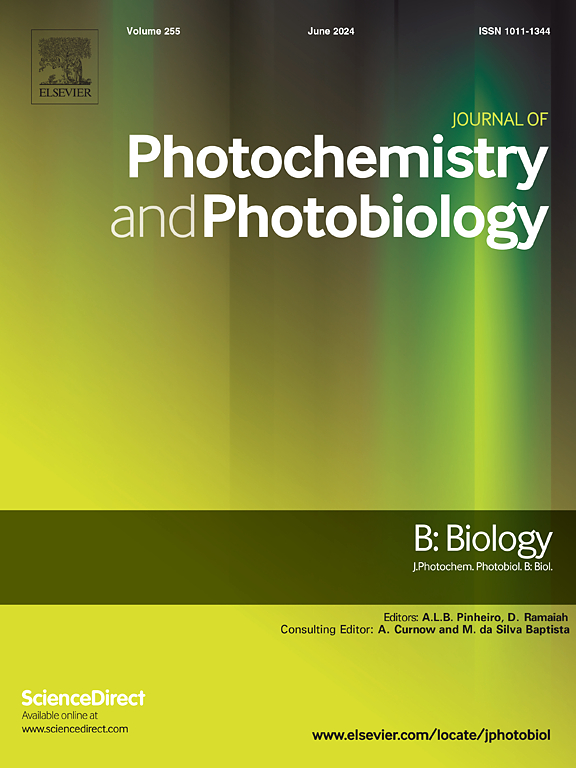Synergistic mechanism of magneto-optical sensing mediated by magnetic response protein Amb0994 and LOV-like protein Amb2291 in Magnetospirillum magneticum AMB-1
IF 3.9
2区 生物学
Q2 BIOCHEMISTRY & MOLECULAR BIOLOGY
Journal of photochemistry and photobiology. B, Biology
Pub Date : 2025-02-12
DOI:10.1016/j.jphotobiol.2025.113124
引用次数: 0
Abstract
Magnetotactic bacteria (MTB), known for their precision in navigating along magnetic fields, also exhibit light-sensitive behaviors. In Magnetospirillum magneticum AMB-1, the photoreceptor Amb2291 is involved in phototaxis regulation and magnetosome synthesis, particularly under oxidative stress. The magnetoreceptor Amb0994 modulates flagellar activity in response to magnetic field changes. Our study used a magneto-optical system to analyze the U-turn motility of north-seeking AMB-1 wild type (WT), amb2291 and amb0994 mutants under reversed magnetic fields and controlled light conditions. The results showed that WT strains consistently executed U-turns in response to magnetic fields, regardless of light variations. The diameters of U-turn of amb0994 mutant were smaller than those of the WT control. When illuminated with blue light in a direction opposite to the magnetic field, Δamb0994 exhibited slower U-turns with diameters similar to WT. In contrast, the Δamb2291 strain exhibited exaggerated U-turn movements under blue light, characterized by larger movement diameters and times compared to the WT, particularly whatever the light propagation direction is the same or opposite to the magnetic field in the initial state of motility. Gene expression analysis revealed that long-term exposure to blue light and magnetic fields led to a significant upregulation of amb2291 in Δamb0994 mutant strains and amb0994 in Δamb2291 mutant strains. These indicate a potential cooperative role of amb2291 and amb0994 in modulating bacterial motility under blue light. This research enhances our understanding of photoreception in MTB and its impact on magnetotaxis, shedding light on how environmental factors interact with microorganisms.
磁响应蛋白Amb0994和lov样蛋白Amb2291介导磁光传感的协同机制
趋磁细菌(MTB)以其沿着磁场精确导航而闻名,也表现出光敏行为。在Magnetospirillum magneticum AMB-1中,光感受器Amb2291参与趋光性调节和磁小体合成,特别是在氧化应激下。磁感受器Amb0994调节鞭毛活动响应磁场的变化。本研究利用磁光系统分析了寻北AMB-1野生型(WT)、amb2291和amb0994突变体在反向磁场和受控光照条件下的u型转向运动。结果表明,无论光照变化如何,WT菌株对磁场的响应都一致地执行u型转弯。amb0994突变体的u型转弯直径小于WT对照。在与磁场方向相反的蓝光照射下,Δamb0994的u型转弯速度较慢,且直径与WT相似。而在蓝光照射下,Δamb2291应变的u型转弯运动幅度较大,其运动直径和次数均大于WT,尤其是在初始运动状态下,无论光传播方向与磁场方向相同或相反。基因表达分析显示,长期暴露在蓝光和磁场下导致Δamb0994突变株amb2291和Δamb2291突变株amb0994显著上调。这表明amb2291和amb0994在蓝光下调节细菌运动的潜在协同作用。这项研究增强了我们对结核分枝杆菌的光接受及其对趋磁性的影响的理解,揭示了环境因素如何与微生物相互作用。
本文章由计算机程序翻译,如有差异,请以英文原文为准。
求助全文
约1分钟内获得全文
求助全文
来源期刊
CiteScore
12.10
自引率
1.90%
发文量
161
审稿时长
37 days
期刊介绍:
The Journal of Photochemistry and Photobiology B: Biology provides a forum for the publication of papers relating to the various aspects of photobiology, as well as a means for communication in this multidisciplinary field.
The scope includes:
- Bioluminescence
- Chronobiology
- DNA repair
- Environmental photobiology
- Nanotechnology in photobiology
- Photocarcinogenesis
- Photochemistry of biomolecules
- Photodynamic therapy
- Photomedicine
- Photomorphogenesis
- Photomovement
- Photoreception
- Photosensitization
- Photosynthesis
- Phototechnology
- Spectroscopy of biological systems
- UV and visible radiation effects and vision.

 求助内容:
求助内容: 应助结果提醒方式:
应助结果提醒方式:


